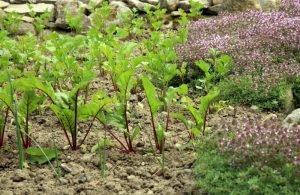Last Updated on May 26, 2025 by teamobn

(Photo: Leeser/Yay Images)
Dill is a popular kitchen herb, flavoring everything from fish
to pickles. Gourmet chefs will tell you that you can’t beat fresh dill for the
flavor.

Fresh dill adds a burst of flavor to salads, soups, and pickles. Growing it at home is simple and rewarding. You just need the right soil, sun, and watering routine. In this guide on how to grow dill you’ll learn easy steps for planting, care, and harvest. You’ll have vibrant, aromatic dill ready to use all season.
How to Grow Dill at Home
Contents
Dill is a versatile herb that can be used in different ways within your kitchen. How our steps below on how to grow dill:
Selecting the Right Soil & Placement
Because dill does not transplant well, you should sow dill seeds directly into the garden after the frost has passed in the spring.
- You should choose a site that has full sun.
- Make sure the area has good drainage and soil that’s rich in organic matter.
- The pH of the soil should be slightly acidic and neutral.
In your garden, plant dill next to cabbage or onions, but
keep it away from carrots. The two plants are closely related and may cross-pollinate.
Make sure to shelter dill from strong winds.
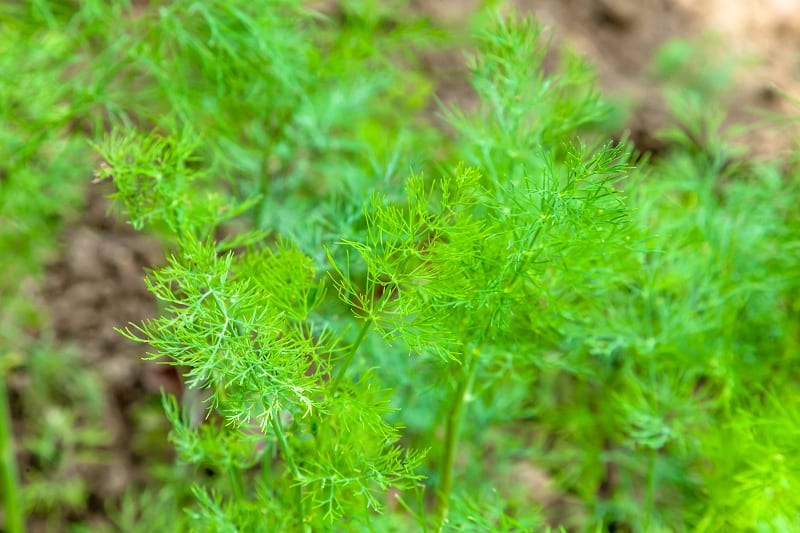
How to Plant Dill
Follow these steps to get dill off to a strong start.
- Select planting time. Sow seeds after the last spring frost when soil is at least 60°F.
Pick a sunny spot. Dill needs six to eight hours of sun and well-drained, rich soil. - Prepare the bed. Loosen soil 10–12 inches deep and mix in compost or aged manure.
Sow seeds. Plant seeds ¼-inch deep and space them 18 inches apart in rows or clusters. - Water gently. Keep soil moist until seedlings appear in 10–14 days.
- Thin seedlings. When sprouts reach 2 inches tall, remove extras so plants sit 12–18 inches apart.
- Mulch lightly. Add a 1-inch layer of straw to hold moisture and cut down on weeds.
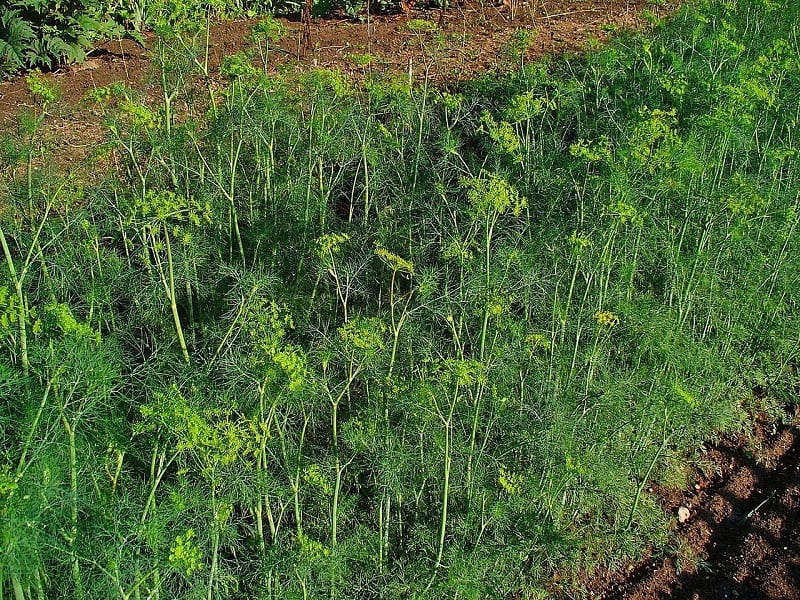
Growing Dill
Follow these steps to keep your dill thriving all season long.
- Water deeply and regularly. Give plants about 1 inch of water per week. Increase to twice weekly in hot weather.
- Thin seedlings. Once sprouts reach 2 inches tall, remove extras so plants sit 12–18 inches apart.
- Succession sow every 3–4 weeks. Plant new seeds in empty spots to extend your harvest.
Mulch around plants. A 1–2 inch layer of organic mulch holds moisture and stops weeds. - Weed and monitor. Pull competing weeds and check for aphids or fungal spots. Treat problems naturally with insecticidal soap or neem oil.
- Allow some plants to flower. Let a few go to seed for free reseeding next year. Collect extra seeds once the pods turn brown.
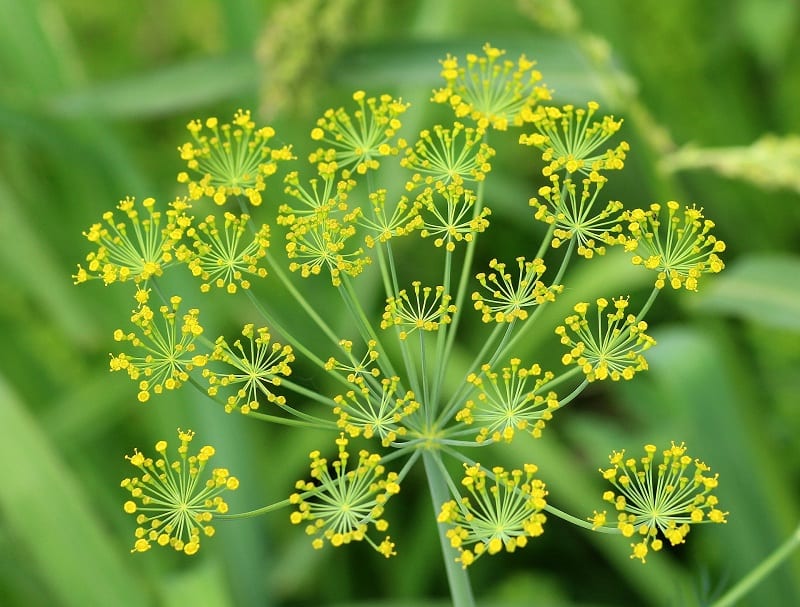
Harvesting Dill
To harvest the dill leaves, regularly trim off the desired amount of leaves you need for cooking. If you wish to harvest dill seeds, allow the plant to grow without trimming until it goes into bloom.
Once dill weed plants go into bloom, they’ll stop growing leaves. Make sure that you don’t harvest any leaves from that plant.
Follow these steps to gather fresh leaves and seeds at their peak.
- Harvest leaves first. Snip sprigs once plants reach 8–10 inches tall for the best flavor.
- Use clean scissors. Cut leaves close to the main stem to avoid bruising.
- Harvest often. Pick every few days to encourage more foliage and delay bolting.
- Allow some to flower. Let select plants bloom for seed production later in the season.
- Collect seeds. Cut brown seed heads into a paper bag and shake to release seeds.
- Dry and store. Spread seeds on a tray until fully dry, then keep in an airtight jar in a cool, dark place.
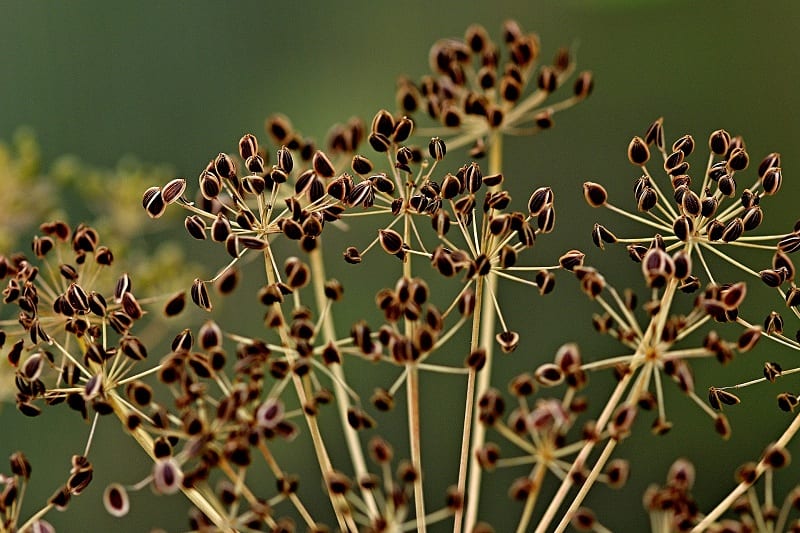
Here’s a quick video…
Managing Pests and Diseases Naturally
Pests and diseases can harm dill leaves and slow growth. You can protect plants using natural care methods that keep herbs safe and healthy.
Beneficial Insects
Ladybugs and lacewings feed on aphids that attack dill. Release these predators near your plants to control pests naturally. You can attract them with flowers like marigolds or yarrow planted at the garden edge. They will hover and hunt across herb beds without any harm to your dill. This method cuts down on sprays and keeps your garden eco-friendly.
Organic Sprays
Insecticidal soap and neem oil can reduce pest pressure on dill. Mix one tablespoon of insecticidal soap per quart of water and spray plants weekly. Test the solution on a few leaves first to check for sensitivity. Apply in the early morning or late afternoon to avoid sun scorch. This organic approach kills soft-bodied insects without harming beneficial bugs or soil life.
Crop Rotation
Rotating crops each season helps prevent soil-borne diseases from building up. Avoid planting dill or related herbs in the same spot two years in a row. Use rotation to break disease cycles and reduce pathogen loads. Follow with a non-herbaceous crop like beans or lettuce. This simple practice keeps your soil healthier and dill plants stronger.
Sanitation and Hygiene
Keep the area around your dill bed clean and free of debris. Remove fallen leaves and spent flowers to cut disease risk. Disinfect tools between beds to stop pathogen spread. Pull any diseased plants immediately and dispose of them away from the garden. Good hygiene habits protect your dill and other crops from common infections.
Soil Preparation and Site Selection
Healthy dill starts with rich soil and the right spot. You can boost growth by testing soil and choosing areas with good sun and drainage.
Sunlight and Drainage
Dill needs six to eight hours of sunlight each day. Pick a spot that drains well after rain to prevent root rot. Raised beds or gentle slopes work best. Avoid low areas where water pools. Good sun and drainage help roots develop and leaves stay lush.
Soil Testing
Test soil pH and nutrient levels before planting. Dill prefers a pH between 5.5 and 7.0. Use a simple home test kit or send samples to a local extension service. Amend soil based on results to correct acidity or nutrient deficiencies. Proper testing ensures your dill gets the right start.
Compost and Organic Matter
Work two to three inches of compost into the top 8–10 inches of soil. Compost adds nutrients and improves structure for better root growth. You can also use aged manure or leaf mold. Organic matter boosts moisture retention and feeds soil microbes. This rich base leads to healthier, more productive dill plants.
Spacing and Air Flow
Space plants 12–18 inches apart to allow air to circulate. Good airflow reduces humidity around foliage and cuts disease risk. Use straight rows or staggered clusters in beds. Avoid crowding with other tall plants that cast shade. Proper spacing keeps your dill strong and disease-resistant.

Dishes and Sauces You Can Make with Dill
Dill adds a bright, tangy note that lifts flavors and dazzles the eye. These recipes show how to use fresh dill to create sauces, dressings, and dishes that impress.
Creamy Dill Sauce for Fish
Whisk together sour cream, mayonnaise, chopped dill, minced garlic, lemon juice, and a pinch of salt. Let the sauce rest for at least 30 minutes in the fridge so flavors meld. Serve alongside grilled salmon, baked cod, or pan-seared trout. The cool creaminess and herbal lift of dill cut through rich fish dishes. This sauce also makes a tasty dip for roasted vegetables or crispy potato wedges.
Lemon-Dill Vinaigrette
Combine fresh lemon juice, white wine vinegar, a teaspoon of Dijon mustard, chopped dill, and a drizzle of olive oil. Season with salt and pepper, then whisk until emulsified. Drizzle over mixed greens, cucumber and tomato salad, or steamed asparagus. The citrus-herb combo brightens simple greens and complements summer vegetables. Store extra vinaigrette in a jar in the fridge for up to a week.
Herbed Potato Salad
Boil baby potatoes until tender, then drain and cool slightly. Toss with a dressing made from Greek yogurt, Dijon mustard, chopped dill, minced shallot, and a splash of apple cider vinegar. Fold in sliced green onions and celery for crunch. Chill for at least an hour to let flavors blend. Dill’s fresh, anise-like taste transforms classic potato salad into a lighter, more aromatic side dish.
Tzatziki-Style Yogurt Dip
Grate cucumber and squeeze out excess moisture with a towel. Stir the cucumber into thick Greek yogurt along with minced garlic, chopped dill, and a splash of lemon juice. Add a drizzle of olive oil and season with salt and pepper. Serve with pita bread, vegetable crudités, or use as a sauce for grilled meats. This cool, creamy dip showcases dill’s refreshing character in every bite.
Dill-Infused Pesto
Blend fresh dill, basil leaves, pine nuts, grated Parmesan, garlic, and olive oil until smooth. Adjust texture by adding more olive oil or a splash of water. Spread on crostini, toss with pasta, or use as a marinade for chicken skewers. Dill and basil create a unique twist on traditional pesto, offering aromatic depth and bright herbal notes. Store in the fridge up to three days or freeze in ice cube trays.
Classic Dill Pickle Relish
Chop cucumbers, onion, and bell pepper into small pieces. Simmer with vinegar, sugar, salt, and a handful of dill sprigs until vegetables soften but retain crunch. Cool and remove dill stems before storing relish in sterilized jars. Spoon over burgers, hot dogs, or mix into tuna salad for an extra zing. Dill infuses the relish with its signature flavor, turning ordinary pickles into a
Delicious and Beneficial
Dill attracts beneficial insects such as wasps and other predatory insects to your garden. The plant is also a host for the caterpillar of the black swallowtail butterfly. Our guide on how to grow dill lets you cultivate this amazing plant at home.
Fresh dill weed begins to droop as soon as you clip it. The herb will begin to lose potency within a couple of days. That is why you should use it as soon as possible.
You can store fresh dill in the refrigerator with stems tucked into a container of water. The dill’s bright flavor is great with potatoes, vegetables, fish, salads, soups, and stews!
Are you ready to learn how to grow dill in your garden?
We have more ingredients you can grow right at home. Check out our guide on starting your vegetable patch!




